This article is Part 2 of our guide for Web3 founders into the ins and outs of creating a Legal Roadmap for their Web3 project. In Part 1, we covered why Web3 projects need a Legal Roadmap, how to approach creating one, and how we help with it at Legal Nodes.
Here's what you will find in Part 2 of the guide:
- Why Web3 projects need legal structuring
- The stages of the development of a Web3 project and the legal work that need to be done at each stage
- Stage 1: Start of Web3 project development and Dev Lab company registration
- Stage 2: Start of early-stage fundraising and registration of a Token company
- Stage 3: Launching the product and preparing the necessary legal documents
- Stage 4: Token launch and preparation of legal documents for token distribution
- Stage 5: DAO launch and structuring a legal wrapper for it
- How to get started with your Legal Roadmap
The need for legal structuring of Web3 projects
In most venture projects, the need for legal structuring arises when these projects begin to attract the first investments. At this point, founders begin to receive questions from investors including whether the project company is registered, whether intellectual property is protected, and whether team members have contracts with the company, for example.
Unlike traditional venture-backed startups that solve these kinds of tasks by registering a classic shareholding company, Web3 startups have more tasks to address, and must do so by creating an appropriate and sufficient legal structure. The main issues that founders will want to address include:
- issuing not only shares for investors but also tokens (or only issuing tokens);
- the possibility of further transformation of the project into DAO with the capitalization of tokens, not shares;
- creating a reliable legal wrapper around the Web3 project to protect the participants of the project (developers, investors, DAO members, etc.) from unlimited liability for DAO activities.
How a Legal Roadmap helps with legal structuring of Web3 projects
Since the legal structure has to solve more business tasks for Web3 startups compared to Web2 startups, it requires a lot more legal work, which can be accurately captured into a Legal Roadmap. These legal tasks include registering a group of companies, conducting legal analysis and obtaining Token Legal Opinions, solving the issue of financial compliance, and more.
Implementing a Legal Roadmap will help Web3 founders create the proper legal wrapper for decentralized app (dApp) operations that underlie every Web3 project and provide an opportunity to attract venture capital. An effective Legal Roadmap for Web3 projects should be divided into several stages, each of which helps solve the project's different business tasks.
Stage 1: Start of Web3 project development and Dev Lab company registration
Every fully decentralized project begins with a centralized development, for which Web3 founders will need to hire software engineers, rent an office, and start paying for the software subscriptions to create a working environment for software engineers. In addition, from the beginning of the project, founders must ensure all intellectual property created in the process is transferred to the company.
To solve these business tasks, Web3 founders usually register a Development Laboratory Company, which hires software engineers, owns IP development rights and is responsible for paying salaries and compensation to contractors. Founders often choose IT/IP-friendly jurisdictions to register the company, which often offer the opportunity of cryptocurrency payments.
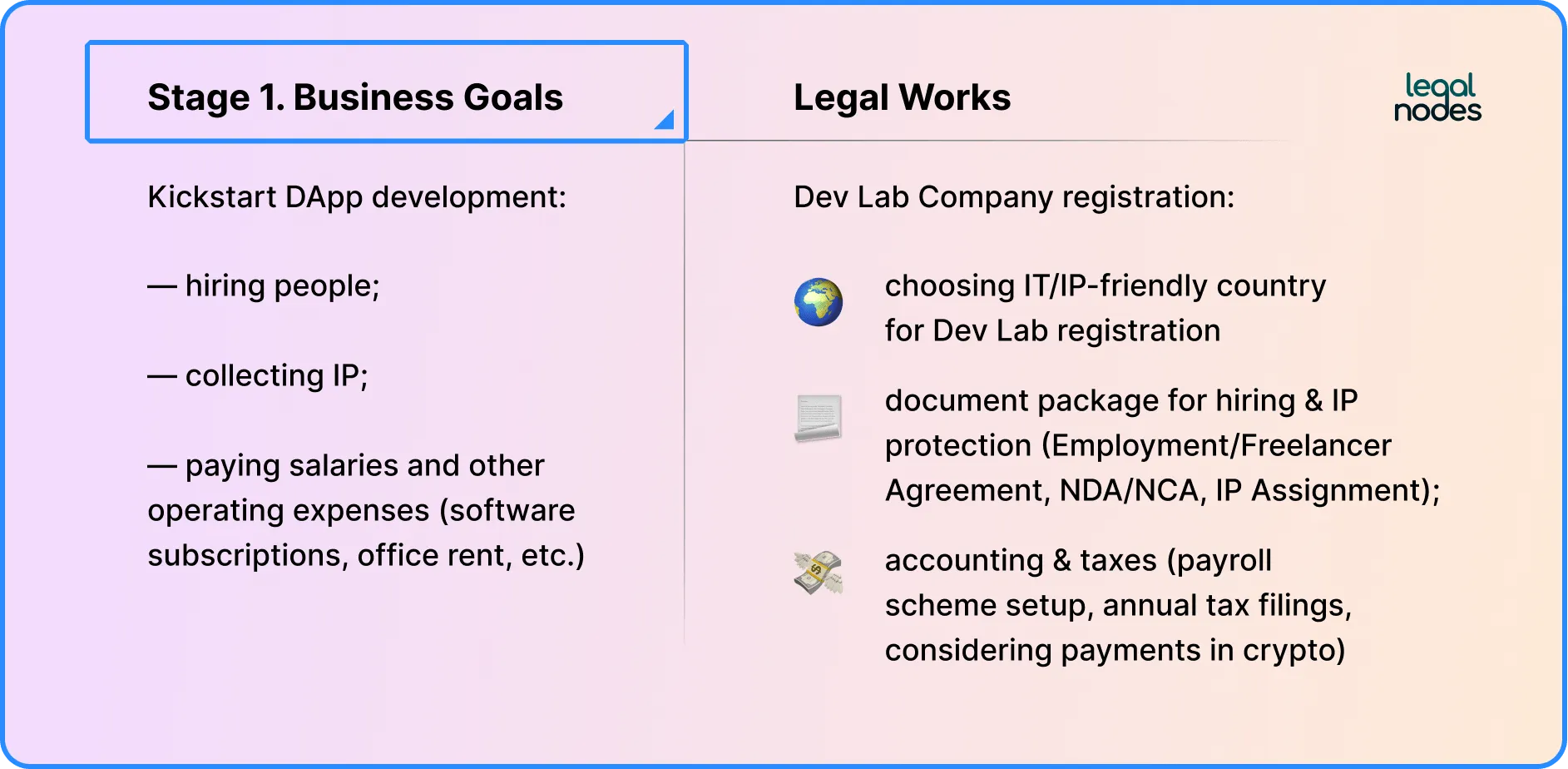
📚 Read more: How to choose a crypto-friendly country for a blockchain business
Stage 2: Start of early-stage fundraising and registration of a Token company
Once the Web3 project team has reached the proof-of-concept of the dApp, they begin to fundraise. At this stage, the Web3 project usually does not issue tokens, but investors who plan to invest in it will be interested in receiving tokens for their investments in the future. At the same time, given the early stage of the project, investors understand that token issuance plans and the tokenomics model of the project may change in the future. Hence, as an additional guarantee for their investments, they count on receiving shares in the project.
This approach of investors in the early stages of fundraising requires founders to register a separate company that will sign investment documents and issue tokens in the future (let’s call it a “Token company”). Most projects need a separate company at this stage because:
- this company must be registered in a jurisdiction that is suitable and acceptable for investments (where venture instruments operate and where investors can protect their rights); and
- the jurisdiction must also have special regulations for token issuance to avoid regulatory barriers that may hinder the future liquidity of tokens.
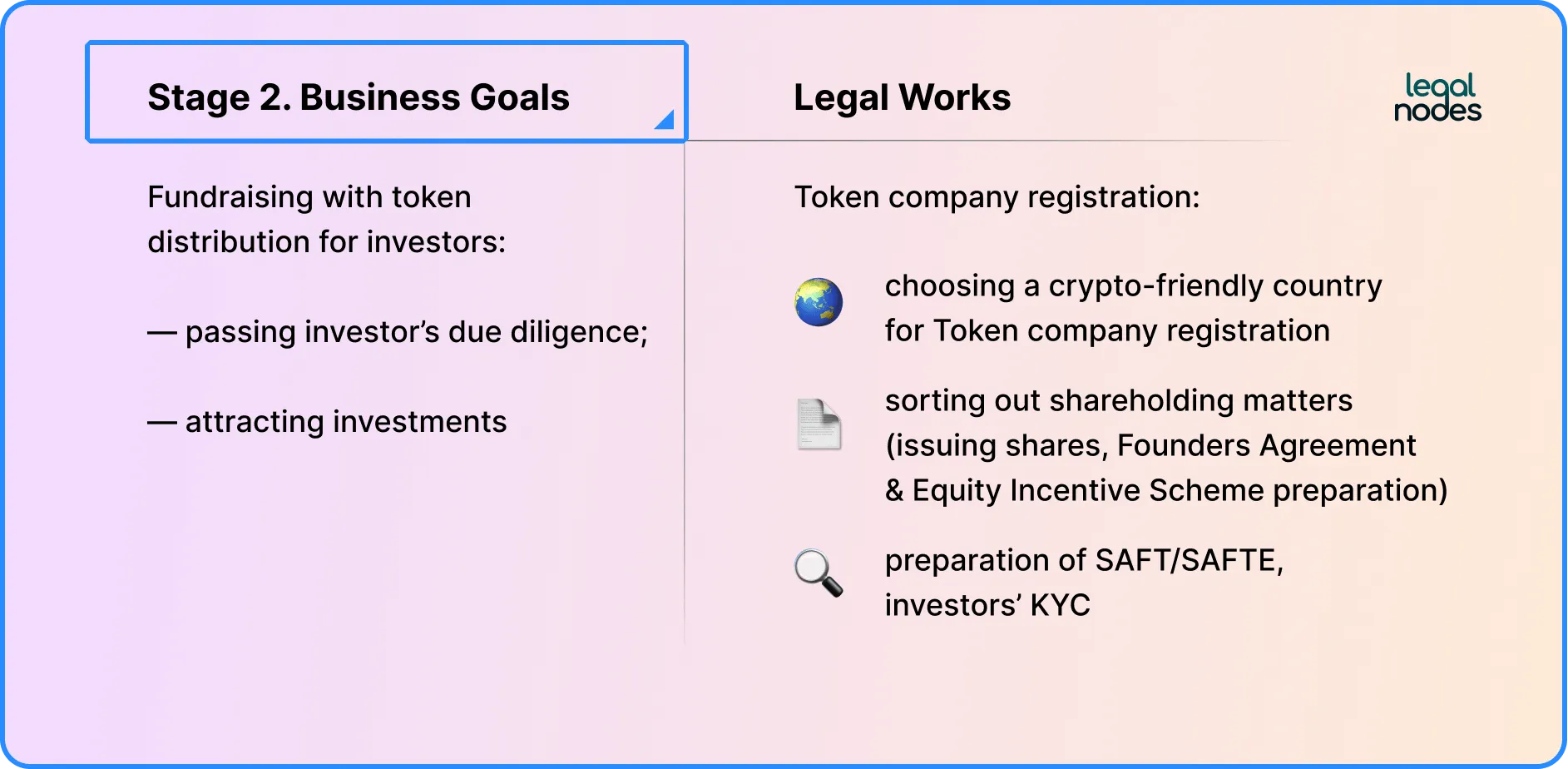
📚 Read more: How to prepare a Web3 startup for fundraising
Stage 3: Launching the product and preparing necessary legal documents
After attracting investments and bringing the dApp to a new stage of development, Web3 founders face the question of how to correctly launch their product on the market and begin to attract users legally. The complexity of this process is that dApps are a set of smart contracts that virtually and completely autonomously "live" and operate in a blockchain network. At the same time, to enable users of these dApps to interact with them, Web3 founders must develop interfaces in the form of websites, mobile applications, and browser plug-ins.
To host websites or list mobile applications in application stores, Web3 founders need to analyze the business model of their dApp carefully to:
- obtain necessary authorizations/licenses for the dApp operation;
- ensure that all details of the dApp are properly reflected in the Terms & Conditions and any policies posted on the website/mobile application of the dApps.
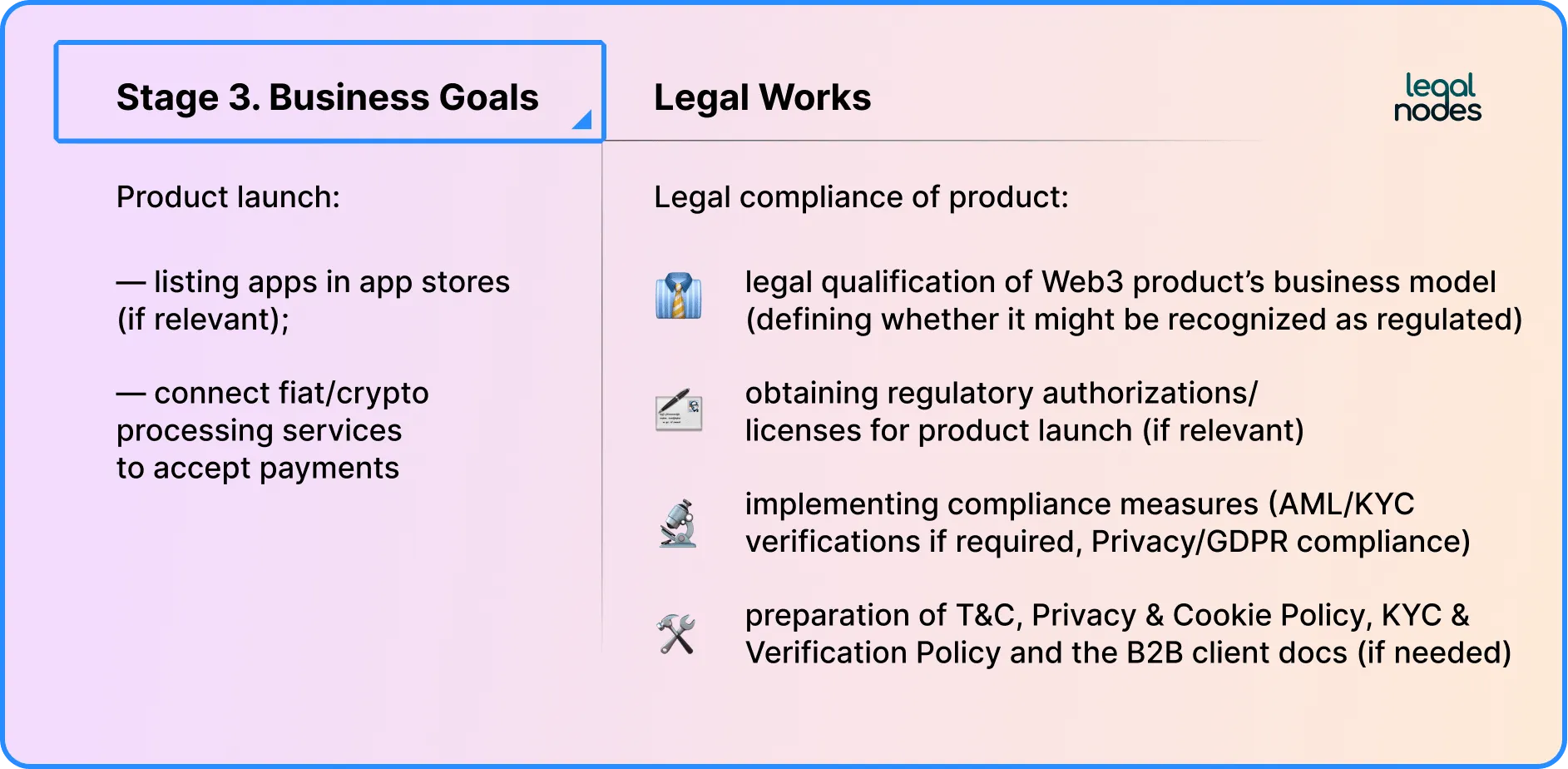
Stage 4: Token launch and preparation of legal documents for token distribution
After launching a dApp on the market, Web3 founders begin to issue their tokens. In most dApps, the purpose of such a token is to increase users' engagement, namely to create additional motivation for users to use the dApp more actively, recommend the product to friends, and spend more time using it. Also, Web3 founders can significantly expand their user base by airdrops or by launching tokens on launchpads. Attracting additional investments can also be done by selling tokens to investors in new rounds of investments.
Each token distribution method requires certain legal works:
- listing tokens on an exchange requires obtaining a Token Legal Opinion;
- selling tokens to investors requires a Token Sale Agreement;
- distributing tokens through airdrops or as the token incentives requires appropriate policies;
- the project might need token approval from regulatory authorities to issue tokens in some cases.
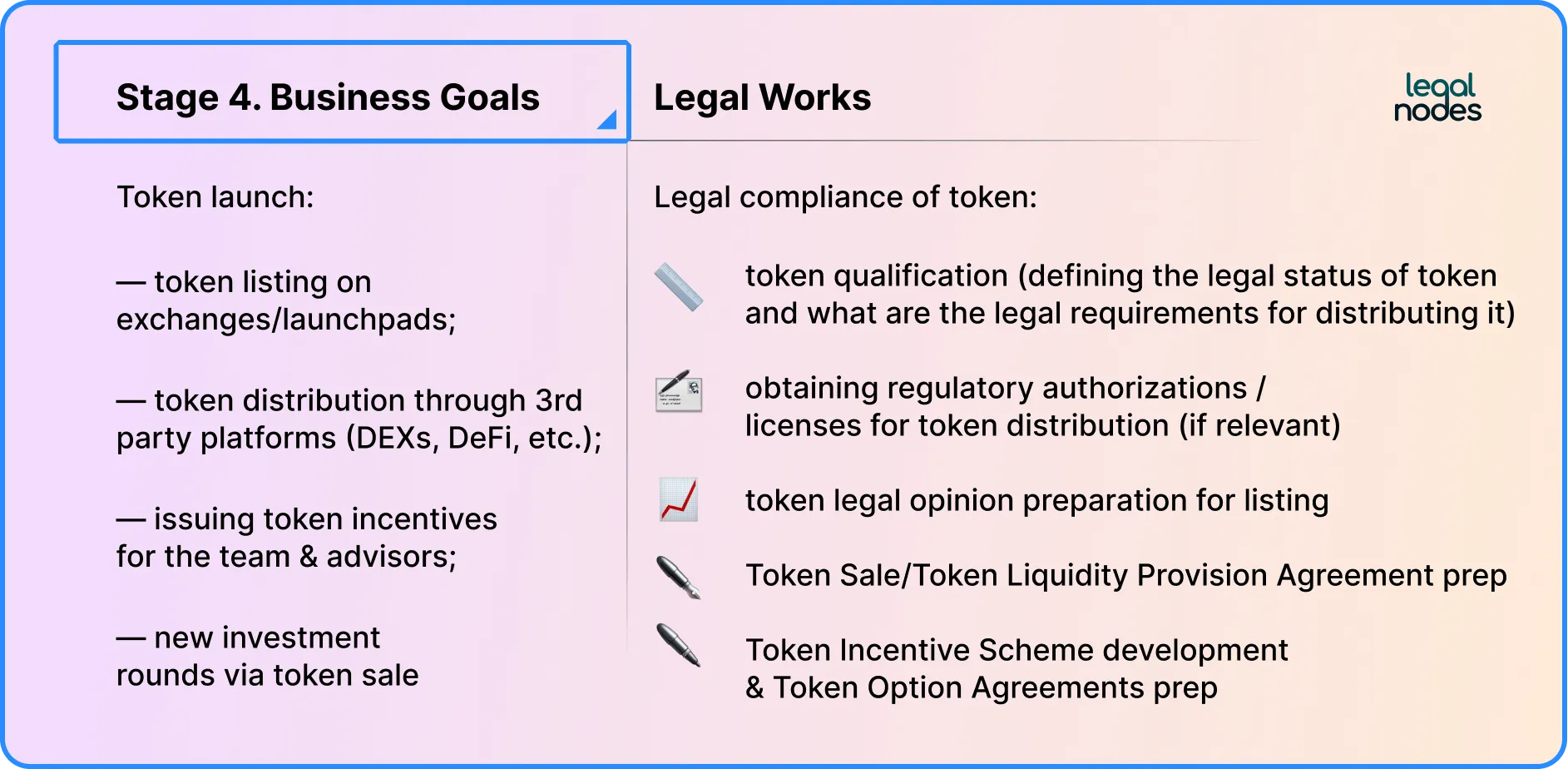
📚 Read more: Models of token distribution and how to legally structure them
Stage 5: DAO launch and structuring a legal wrapper for it
After launching a dApp, attracting customers and issuing tokens, the project enters a stage of active growth. The nature of dApps suggests that this type of project is completely decentralized and autonomous, meaning it has no centralized administrators or final beneficiaries. Therefore, at some stage in the development of a dApp, many Web3 founders think about “transferring” the project to the full disposal and management of the project community.
This transition involves the organization of decentralized governance and decentralized treasury management. The rules of decentralized project management are programmed in a smart contract and allow DAO members to participate in voting for changes to the rules of smart contracts operation, as well as for ways to manage the DAO Treasury. The main legal works in this process will create a proper Legal Wrapper for different members of the DAO community. In other words, founders need to register a DAO company which will protect DAO members from unlimited liability for DAO activities, allow for a legally binding voting process, and ensure compliance with the procedures in the process of DAO Treasury management.
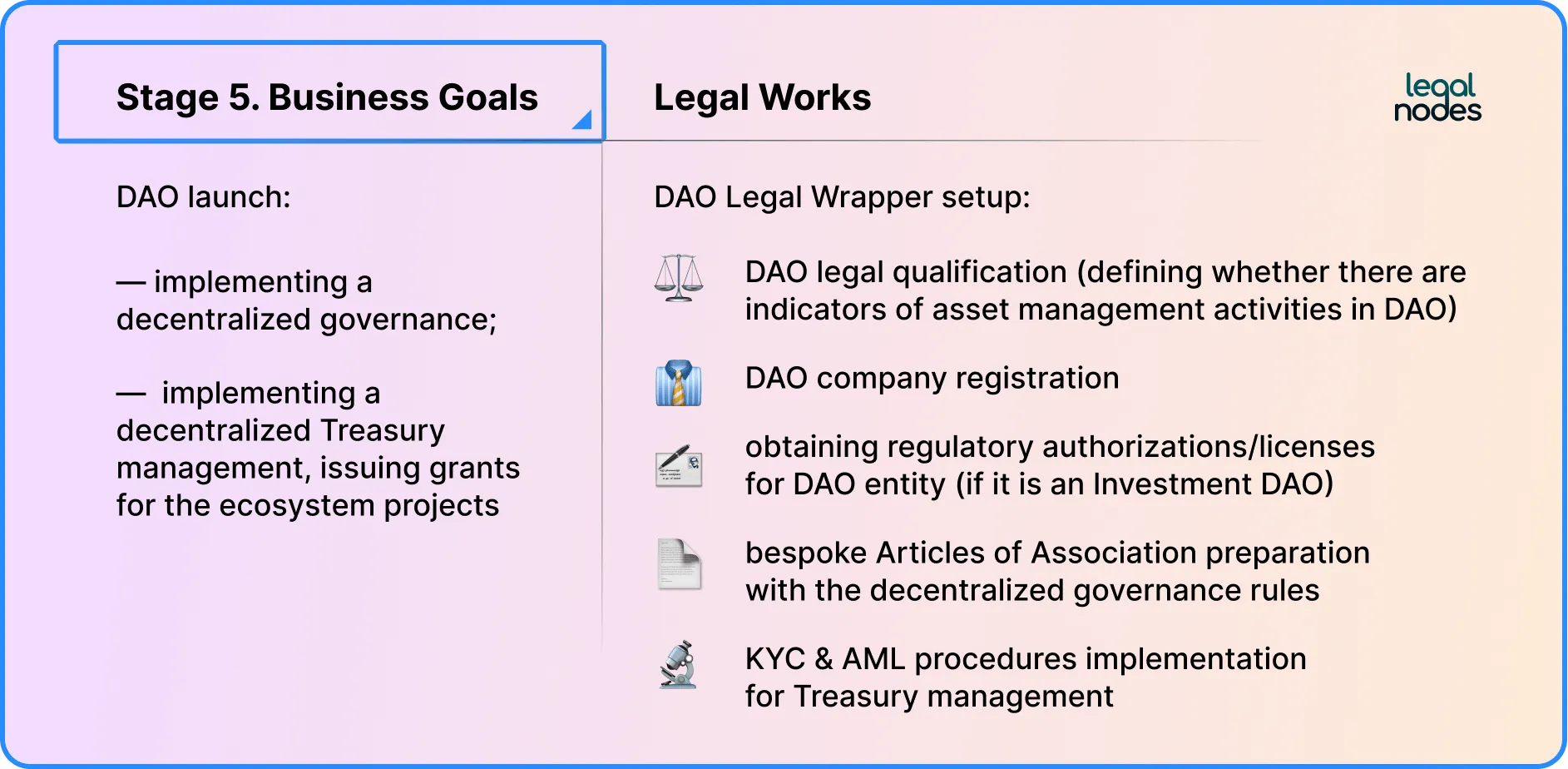
📚 Read more: How to choose a crypto-friendly country for DAO legal structuring
Getting started with a Legal Roadmap
Each business task of the Web3 project, which involves the interaction of virtual and autonomous dApp with the real centralized world of application stores, payment systems and venture funds, requires Web3 founders to do legal work to build “bridges” between the two worlds (centralized and virtual decentralized). It is essential for Web3 founders to prepare a detailed Legal Roadmap in advance, to help plan their business activities and project budgets.
Given that Web3 regulation is at an early stage of development and there is a high level of regulatory uncertainty in the industry, a well-thought-out Legal Roadmap becomes even more relevant as it will allow Web3 funders to avoid many troubles and risks in the future.
Usually, founders think about creating a Legal Roadmap when the need to interact with a centralized world arises or when they plan to raise funds for the project. It is best to start with a consultation with a legal specialist who understands the crypto market and recently introduced regulations, and also has information on the most crypto-friendly countries and best practices of Web3 project structuring.
If you'd like to learn more about our Legal Roadmaps and how Legal Nodes can help structure your project, fill out the form on our website.
Disclaimer: the information in this article is provided for informational purposes only. You should not construe any such information as legal, tax, investment, trading, financial, or other advice.
Nestor is a Co-founder & Head of Web3 Legal at Legal Nodes. Having over eight years of legal consulting experience, Nestor loves working with innovative startups and Web3 projects, helping them navigate the regulations and scale on global markets.
